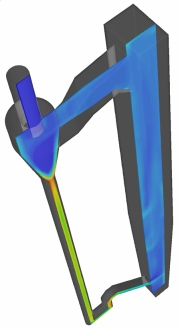By virtue of the many physical processes we are often attempting to simulate in a virtual environment, CFD can be a complex beast. To accurately account for all real-world behaviour, the CFD engineer must consider the applicability of a large number of physical effects, including complex turbulence, compressibility, various modes of heat transfer and, last but certainly not least, the interaction of multiple phases comprising liquid, gaseous and solid components.
Even if you have mastered all of your geometry and meshing requirements, and undertaken many years of single-phase CFD simulations, it can still be a daunting task when you are asked to tackle your first multiphase CFD problem. Before you begin, we recommend that you ask yourself the following:
[1] For each phase in your system (gas/liquid/solid), make a decision on whether it should be considered as a continuous phase (which assumes all regions of this particular material are connected) or as a discrete phase that is dispersed throughout the domain (e.g. droplets, particles or bubbles).
[2] For each continuous phase, decide whether the flow is laminar or turbulent by evaluating a characteristic Reynolds number for your problem.
[3] Determine the Stokes number for each dispersed component and decide if it will follow the continuous flow closely (smaller Stokes numbers, typically < 0.01) or move largely independently of it (larger Stokes numbers, typically >1).
[4] For each dispersed phase, based on your understanding of the real physics, decide whether it is necessary to model a wide range of sizes (of droplets/particles), or whether your modelling goals can be achieved by modelling the system with a single size or just a few representative size classes.
[5] Decide whether assessing changes to the characteristic size of the dispersed phase (e.g. increasing/decreasing droplet or bubble diameter) will be important for your CFD modelling goals.
[6] If so, assess the mechanism that is causing this breakup or coalescence. The Weber number describes the ratio of inertial forces to surface tension forces acting on the droplet, and can be used to help you decide the dominant breakup mechanism. Typically the droplet will be stable for Weber Numbers less than 6.
[7] Review whether gravitational effects are important. The Bond number helps you assess this as it describes the ratio of gravitational forces to surface tension forces.
[8] Review whether surface tension effects are important. Check your Capillary number, which is the ratio of viscous forces to surface tension forces. The appropriate ranges where surface tension can be neglected can be heavily problem dependent, so please contact us if you require for more information on this area.
[9] How do you need to present your CFD results? Will it suffice to report an average value of some key variables (such as the average velocity or temperature in particular regions) or do you need to have more detailed reports on the history of a particular dispersed entity? For example, if you want to model the drying of a milk droplet in a spray dryer, or combustion of a coal particle, the history of key variables along the particle trajectory are important quantities to capture in your CFD results.
[10] Consider how large the volume fraction of each particular dispersed phase can become within your domain of interest? If the maximum volume fraction is still less than about 5%, then often the interactions between particles will be negligible. Conversely, if the volume fraction is likely to approach the packing limit (typically around 60% but varies according to particle type/shape), then additional physical models can be activated to prevent over-packing.
Using carefully considered responses to the above questions, you will now have characterised your multiphase system and it is possible to move to the next step: How to select the most appropriate multiphase modelling approach for your multiphase CFD simulation (which is covered in our next post in this series)...






